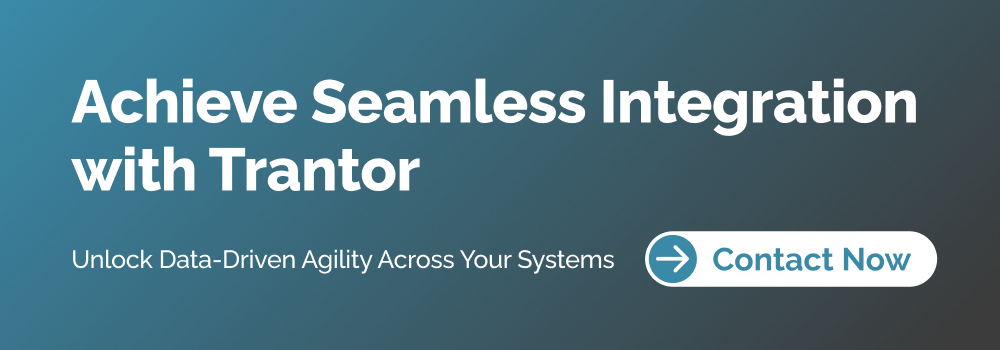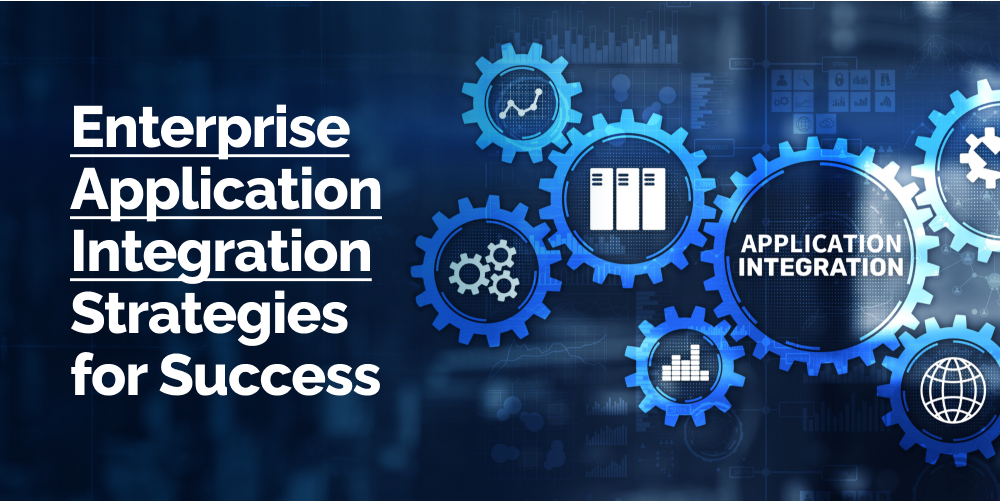Enterprise Application Development, zBlog
Enterprise Application Integration: Key Strategies for Success
Team Trantor | Updated: February 20, 2025
Enterprise Application Integration: Introduction
In today’s hyperconnected business landscape, organizations rely on a multitude of applications and systems to manage their operations and drive growth. Supply chain management, HR, sales, marketing, and finance – critical business functions are now largely digital, powered by specialized software solutions.
While this technology-first approach enables process optimization, it also creates integration challenges. Data and workflows often get trapped in organizational silos, obstructing the free flow of information. Companies that don’t bridge the gap risk inefficiency, poor visibility, and lack of agility.
This underscores the immense value delivered by enterprise application integration (EAI). By seamlessly linking disparate systems, EAI liberates data and facilitates real-time coordination across the enterprise. The payoff includes increased productivity, lower costs, and the ability to rapidly adapt to market dynamics.
As per leading industry estimates, the EAI solutions market is poised for robust growth, expected to reach $17.4 billion by 2027 compared to $11.9 billion in 2022. The compound annual growth rate or CAGR is projected at 9.8% during this period.
In this comprehensive guide, we explore what effective EAI entails in the current business context. We dig into key integration architectures, must-have capabilities, implementation best practices, and how to drive maximum value.
Let’s get started.
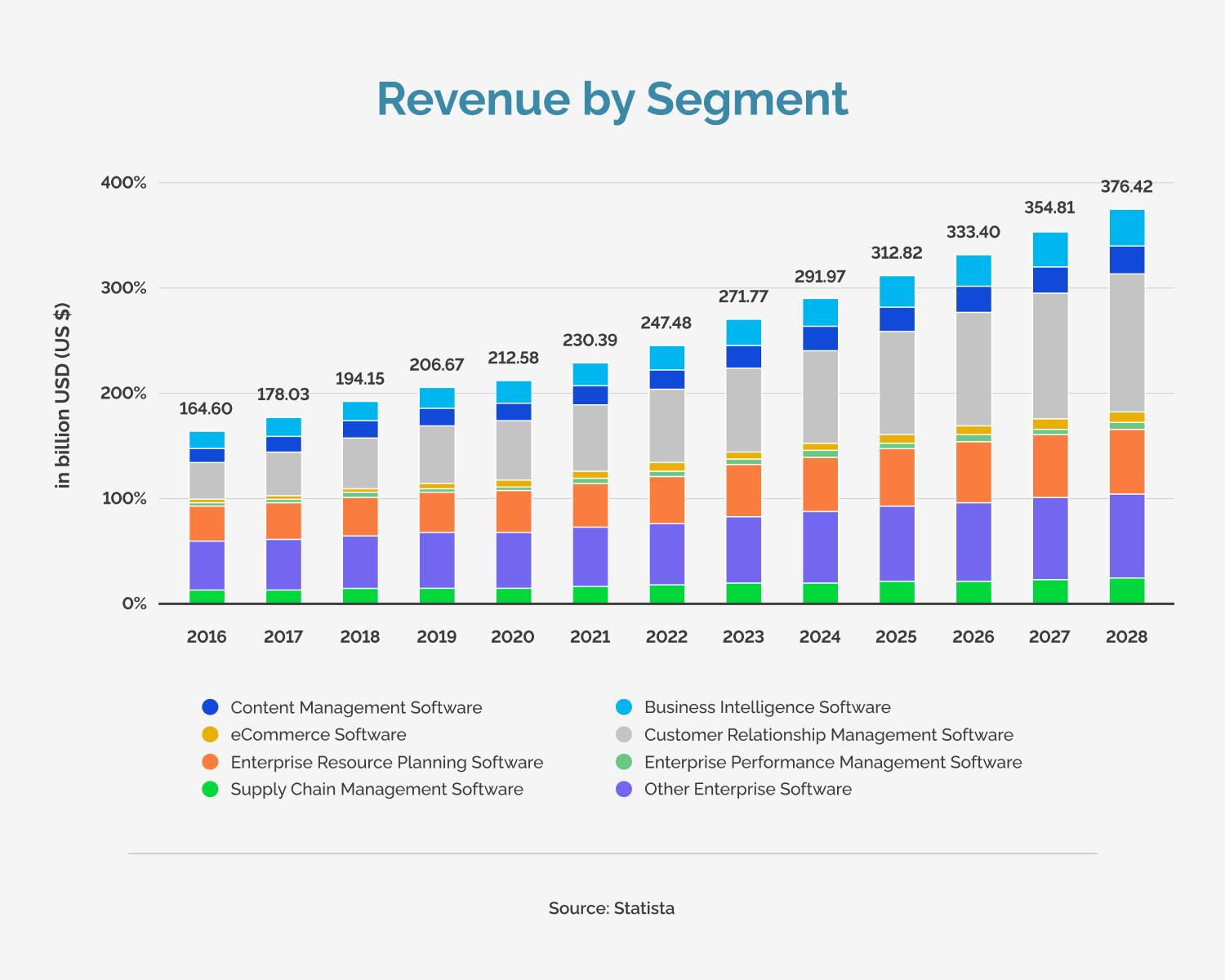
The Business Imperative for Integration
For companies using dozens or even hundreds of customer relationship management (CRM), enterprise resource planning (ERP), supply chain management (SCM), and other business applications, integration is non-negotiable.
Without it, organizations face continuous friction as data gets trapped in application silos. Employees waste time piecing together insights from separate sources versus focusing on value-creating tasks. Opportunities are missed as teams lack complete visibility across the value chain.
According to leading consulting firm McKinsey, typical companies lose 20-30% in productivity due to poor integration and data accessibility issues. This burden is felt across business units:
- Sales/Marketing: Inconsistent customer data across systems hampers lead generation and campaign management.
- Finance: Consolidating data from regional ERP systems is manual and time-consuming.
- HR: Onboarding new employees involves cumbersome paperwork as HR systems don’t integrate with other platforms.
- Supply Chain: Lack of coordination across suppliers and distribution centers causes shipment delays.
The list goes on. In essence, any area that relies on cross-functional data exchange and workflows suffers in the absence of integration. Even as business applications evolve at a rapid clip, integration remains the foundational glue holding organizations together.
Beyond addressing productivity bottlenecks, EAI promotes other critical business outcomes:
- Customer Experience – By providing a unified customer view across all engagement channels and touchpoints.
- Business Agility – Through open architectures that allow new systems and partners to be onboarded faster.
- Analytics – Breaking down data silos provides deeper visibility into performance for better decision-making.
- Growth – Seamless coordination enables geographic and product/service expansion.
EAI is thus more than a tactical IT concern – it is a core business capability underpinning competitive success.
EAI 101: Key Concepts
Before exploring Enterprise Application Integration (EAI) strategies and implementations, let’s quickly cover some must-know concepts:
What is EAI?
Enterprise application integration (EAI) refers to the technologies, tools, and processes used to connect software applications across an organization. This enables seamless data exchange and automated cross-functional workflows.
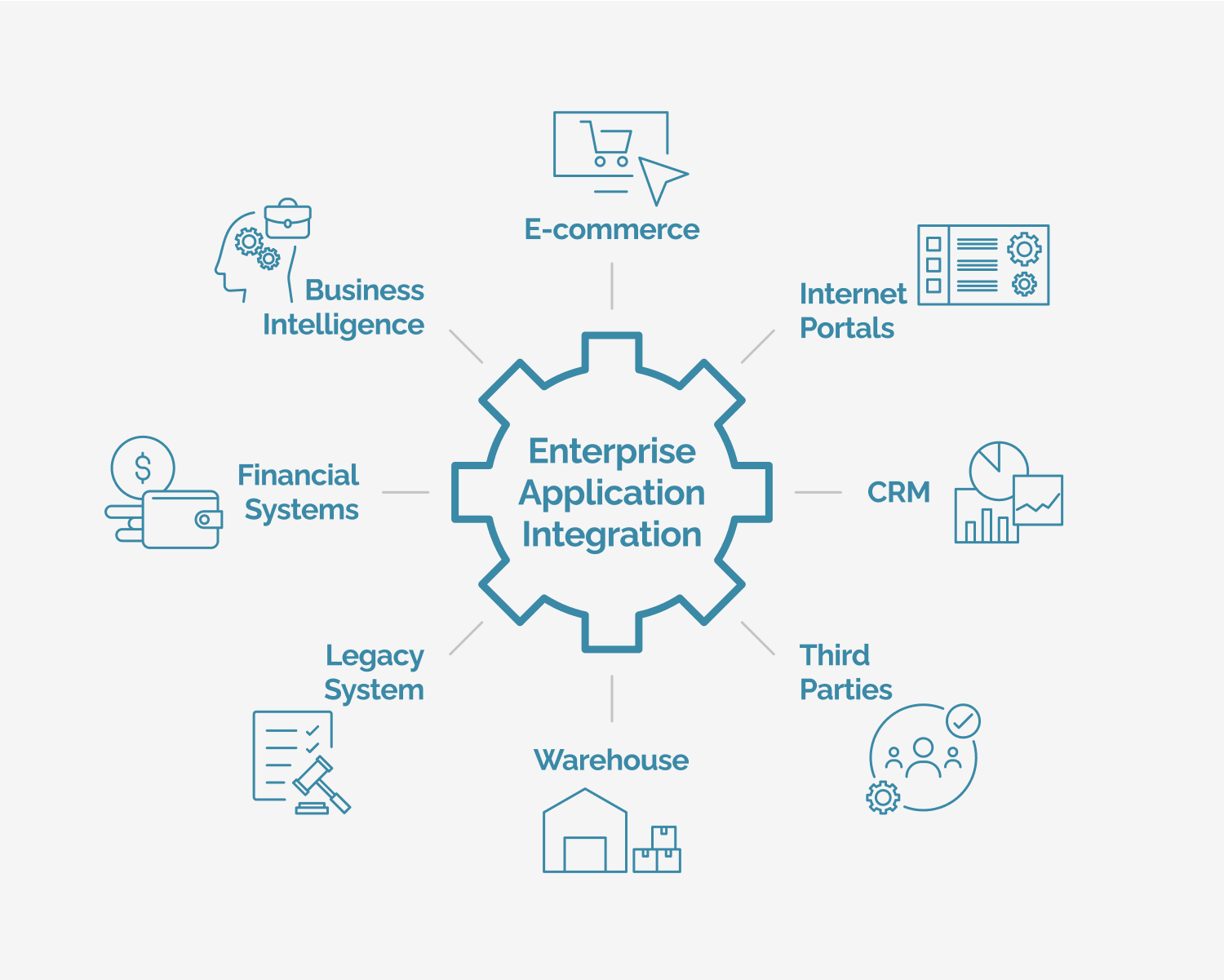
EAI Components
EAI solutions have multiple layers, including:
- Connectors – Interface with target applications via APIs and adapters.
- Messaging – Routes communication between applications using buses and brokers.
- Data Transformation – Maps data between application formats and schemas.
- Orchestration – Manages sequencing of process flows and business rules.
- Monitoring – Provides visibility into integration jobs, data traffic, errors, etc.
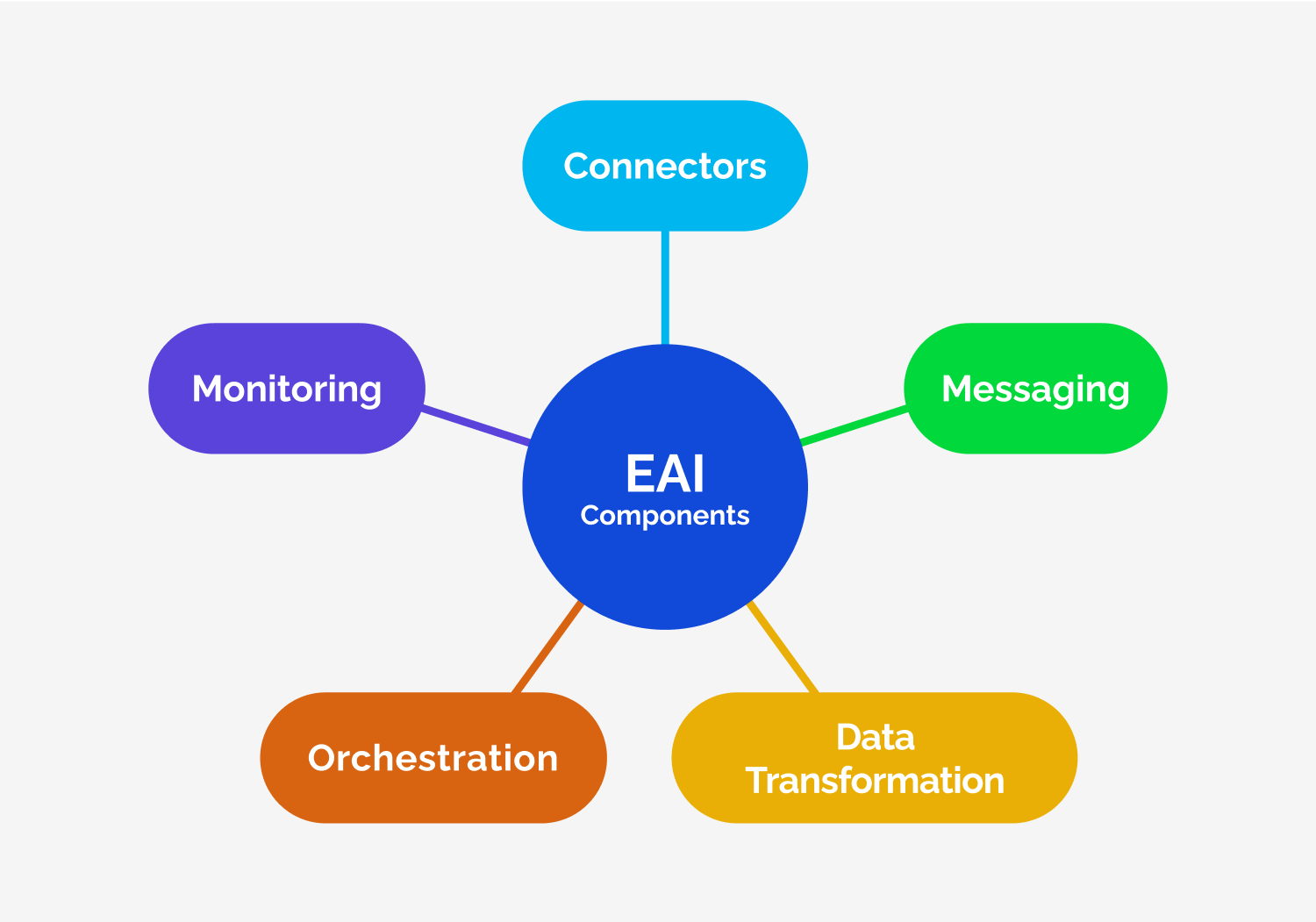
Integration Styles
Enterprise Application Integration supports everything from real-time data streaming to batch data transfer using two core approaches:
- Service-oriented architecture (SOA) – Applications expose functionality as services that other systems can access and orchestrate.
- Message-oriented middleware (MOM) – Applications communicate by publishing data and subscribing to events over a message bus.
On-Premise vs. Cloud
EAI can be implemented via on-premise software and appliances or cloud platforms like Microsoft Azure, Amazon AWS, and Oracle Cloud. The optimal approach depends on existing infrastructure, use cases, and other factors.
Now let’s explore EAI in-depth.
Planning EAI Initiatives: Where to Begin
Embarking on enterprise-wide integration is complex. Success requires aligning business strategy, IT roadmaps, and EAI capabilities into a cohesive initiative. This strategic planning is integral before getting into technical implementation.
Here are key focus areas for EAI planning:
Define Business Drivers and Goals
First and foremost, the program must target tangible business outcomes beyond just technical connectivity. Common goals include:
- Increase sales by providing a 360-degree customer view
- Streamline financial reporting by linking regional data
- Accelerate order fulfillment cycles via supply chain integration
These goals anchor the initiative and guide technology decisions.
Audit Existing Application Landscape
Gaining a thorough understanding of existing applications and their interdependencies is crucial. Key questions to address:
- Which applications are most critical for targeted business processes?
- What legacy systems need to be maintained during integration?
- What data formats and standards are used?
- Which applications have native integration capabilities versus which require adapters?
- What regulations apply to the data being exchanged?
This audit establishes the scope and informs planning.
Build a Phased Roadmap
A phased, iterative rollout focusing on priority business outcomes is recommended over a big-bang approach. For example:
- Phase 1 – Integrate CRM and marketing applications to enable seamless lead handling
- Phase 2 – Connect supply chain systems to gain end-to-end visibility
- Phase 3 – Link regional ERP platforms to facilitate centralized reporting
Perform Cost/Benefit Analysis
The projected costs of the program should be validated against expected benefits across fronts like productivity, customer experience, and time to market. This analysis also helps secure the required budget and resources internally.
Adopting this strategic approach lays the groundwork for EAI’s success. With business context and requirements validated, we can now explore key technical considerations.
Choosing the Right Integration Architecture
EAI programs involve significant technology investments. Selecting the appropriate integration architecture is critical to maximize value and minimize the total cost of ownership. Let’s examine key options.
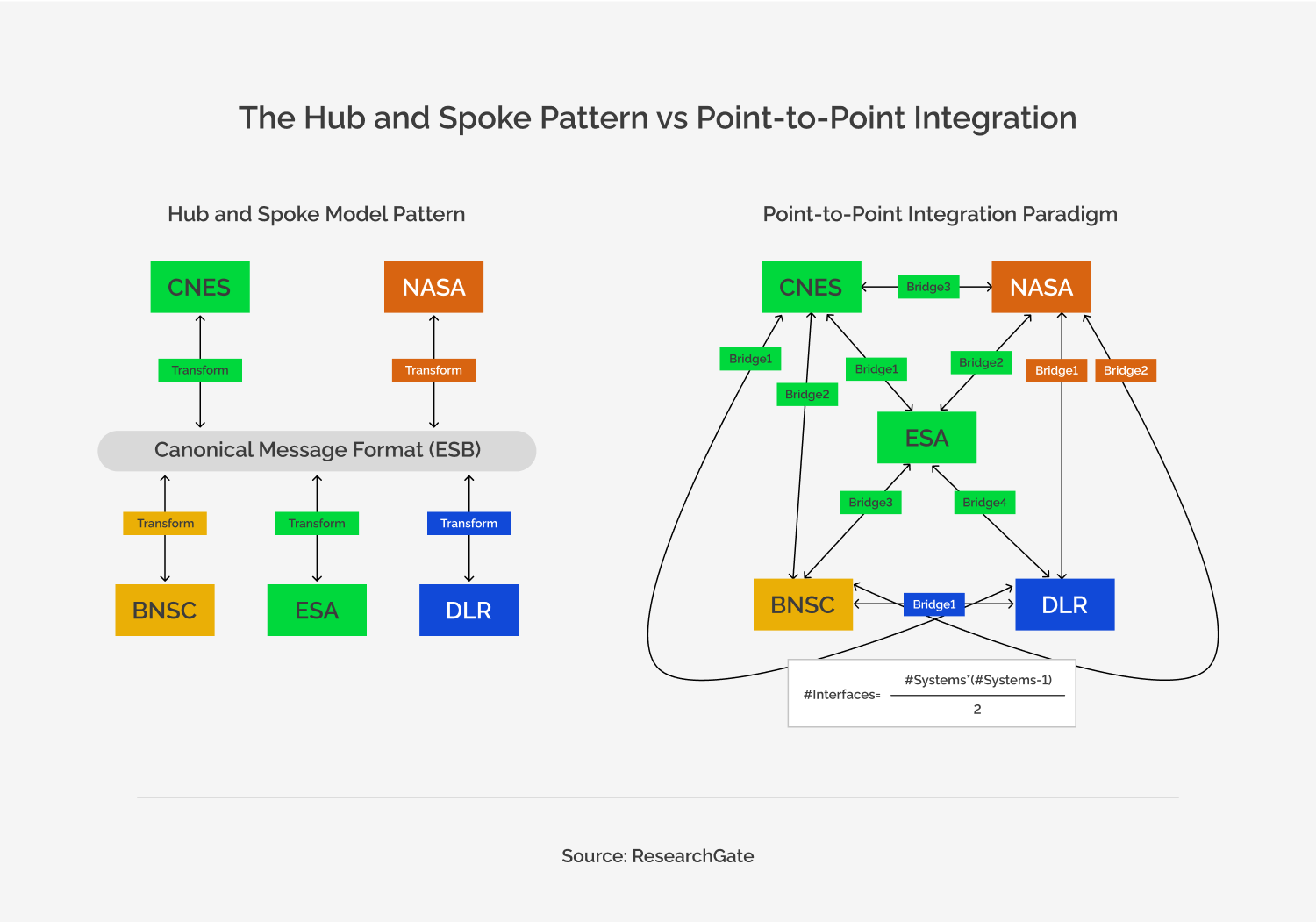
Point-to-Point Integration
This method connects applications directly rather than through an intermediary. It offers simplicity up front but does not scale well as integration needs to grow in complexity and volume. Managing all the interconnected links also grows cumbersome.
Use Case – Small-scale, tactical application integration.
Hub-and-Spoke Integration
Here, applications connect via a central integration hub that handles routing and coordination. While more advanced than point-to-point, it can still suffer performance issues as throughput rises.
Use Case – Departmental application integration.
Message Bus Integration
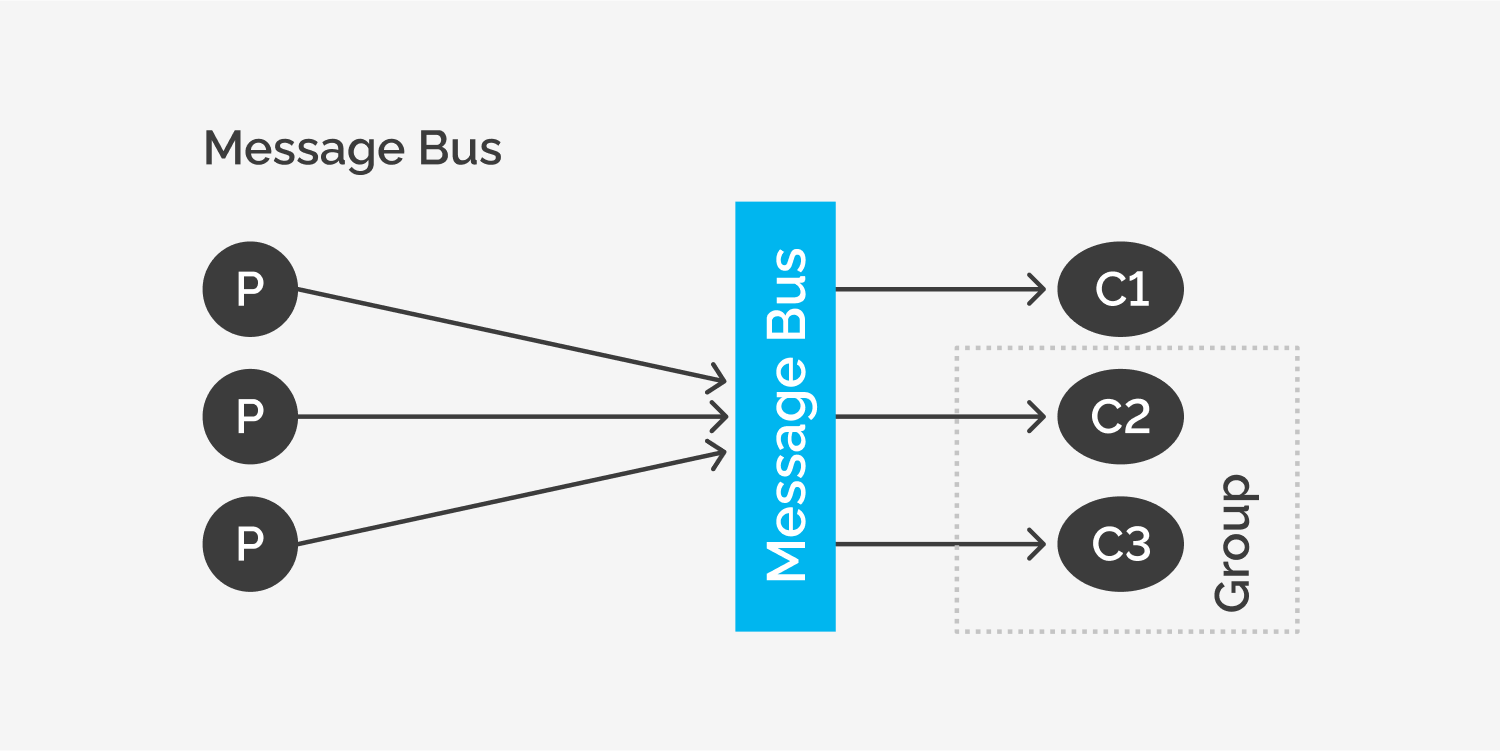
A message bus allows applications to asynchronously communicate via events, queues, and streams. This supports high-volume, real-time integration demands with built-in scalability.
Use Case – Enterprise-wide integration spanning mission-critical applications.
Hybrid Integration
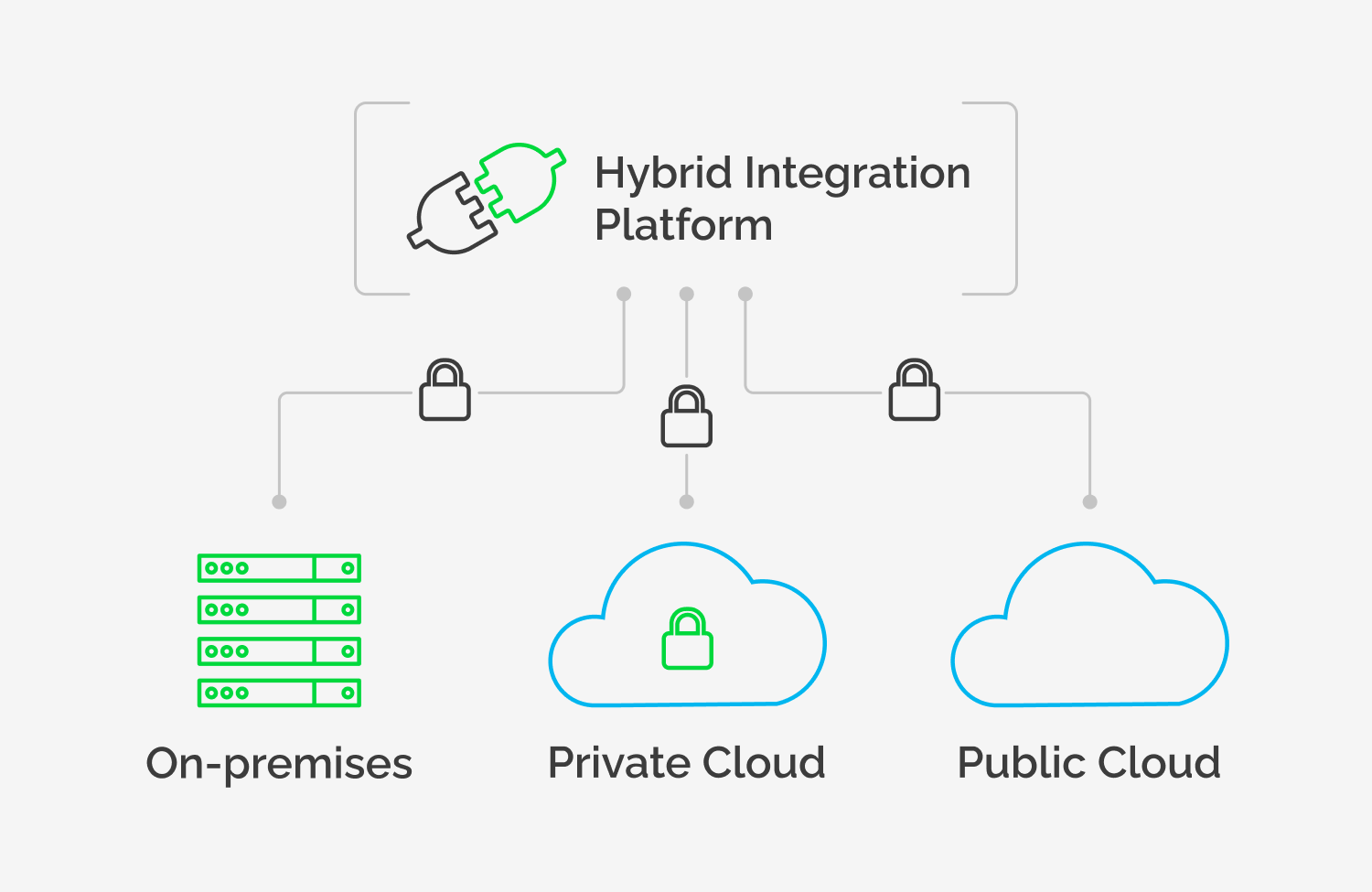
As needs evolve, a hybrid model combining point-to-point, hub-and-spoke, and message bus can provide ultimate flexibility. But it also increases complexity.
Use Case – Complex enterprise application portfolios.
While message bus emergence has fueled growth in cloud integration platforms, organizations also continue to use on-premise hubs and ESBs based on workloads and security considerations.
Must-Have Capabilities and Features
Beyond core architecture, EAI solutions must incorporate a variety of capabilities:
- Robust Connectivity – Support for broad application connectivity via APIs, adapters, agents, etc. is essential. This should span standards like HTTP/S, JDBC, FTP, SFTP, and proprietary protocols.
- Data Mapping – Mapping data across different application formats and schemas are crucial for avoiding misinterpretation and errors.
- Workflow Orchestration – EAI solutions must sequence multi-step process flows while applying business rules, transformations, and decision logic.
- Monitoring and Analytics – Tracking integration tasks, data traffic, performance metrics, and errors in real time is vital for management and troubleshooting.
- Security – Encryption, access controls, and other security features protect sensitive data while meeting compliance demands.
- Scalability – EAI infrastructure must flexibly accommodate increases in workload volumes and complexity driven by business growth and expansion.
- Resiliency – Mechanisms for failure recovery, retries, degraded performance mode, etc. provide operational reliability.
- DevOps Integration – Integration with leading DevOps tools like Jenkins, Git, and unit testing frameworks maximizes agility.
- API Management – For SOA-based integration, capabilities to publish, secure, orchestrate, analyze, and monetize APIs.
- Microservices Support – Integration with and development of microservices that can be collectively orchestrated.
These features allow Enterprise Application Integration to address a diverse array of enterprise integration needs – from mainframe legacy systems to cloud-native applications and everything in between.
Navigating Implementation: Best Practices
With so many moving parts, EAI projects carry risks of cost/schedule overruns, under-delivery, and low adoption. Here are proven best practices to drive smooth execution:
- Executive Sponsorship – Ensure an executive champion to secure buy-in across teams and align priorities.
- Phased Rollouts – Take an iterative approach spreading integration modules over multiple release cycles.
- User Involvement – Incorporate feedback from business application users early and often during design.
- Legacy Planning – Factor in dependencies on legacy systems and create transition plans.
- Data Governance – Institute data stewardship early to enforce standards and compliance.
- Testing Automation – Automated test cases and scripts accelerate validation while enhancing quality.
- Monitor Adoption Metrics – Track usage data by application to ensure benefits realization.
- Ongoing Enhancements – Build agility to quickly incorporate new endpoints and workflows.
- Training and Support – Provide resources to help business users transition to integrated environments.
Taking this structured approach drives results while also providing a foundation for continuous innovation as integration needs to evolve.
Real-World Success: EAI in Action
To understand EAI’s real-world impact, let’s look at examples from two leading global enterprises:
Automaker Optimizes Supply Chain Collaboration
A major automaker faced massive delays coordinating its vast supplier ecosystem. Their legacy integration system hindered data sharing and process coordination.
By implementing a cloud-based strategic integration platform, they gained real-time visibility into production schedules, inventories, and shipments across suppliers. Multi-tier supply chains are now orchestrated seamlessly, accelerating production.
Benefits
- 28% improvement in supply chain efficiency
- $62 million in savings from reduced inventory costs
- 25% faster time-to-market for new vehicle models
Energy Company Boosts Customer Experience
For an energy company with 5 million customers, fragmented and inconsistent subscriber data was impacting customer support and satisfaction.
Their new EAI solution integrated billing systems, smart grid applications, and customer management and enterprise software on a centralized message bus. Accurate, unified data is now delivered across engagement channels.
Benefits
- 10% rise in customer satisfaction score
- 72% faster resolution of account issues
- 15% increase in first-call resolutions
- $5.3 million saved annually via productivity gains
These examples highlight how strategic investment in EAI pays both short and long-term dividends across operational efficiency, costs, innovation velocity, and customer relationships – the pillars of business success.
Blazing a Path to Seamless Integration
As companies seek to optimize performance in today’s highly competitive and fast-changing business landscape, integrated IT increasingly serves as the catalyst. Breaking down decades-old applications and data silos unlocks immense potential.
By following structured approaches to drive strategy alignment, architectural design, capability integration, and lifecycle governance, organizations can maximize their integration ROI. Enterprise Application Integration morphs from a one-time project into an adaptive digital platform.
While the road to seamless integration contains twists and turns, the destination is a future-ready enterprise ready to accelerate into the digital beyond.
At Trantor, our certified integration experts and available solutions empower organizations to effectively bridge systems and liberate their digital potential.
